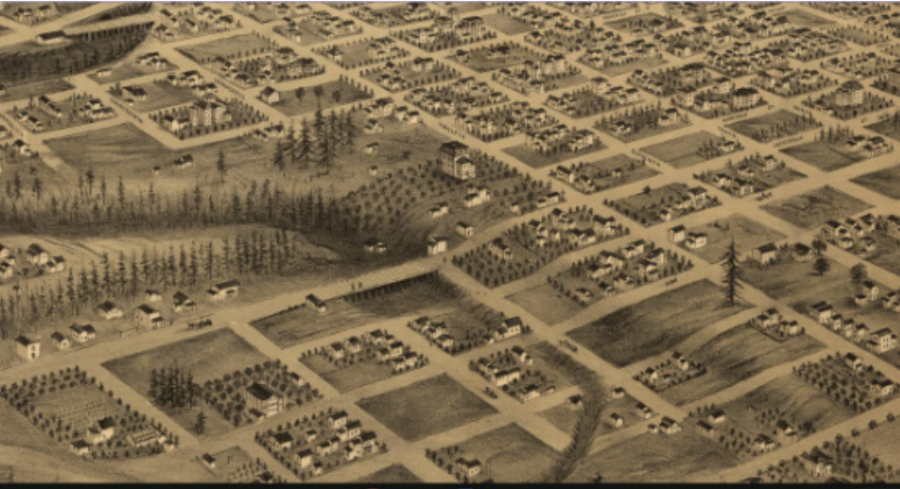Lincoln’s roots run deep
Vintage Portland Archives Lithography
Kamm House and Tanner Creek in 1880s is now the current land that Lincoln is located.
In addition to Lincoln’s academic, athletic and cultural history, the school’s location has a rich past of its own. The oldest public school in the city, Lincoln has occupied three different plots of land, most recently its current location on SW 12th and Salmon Street.
The current plot of land was previously occupied by Tanner Creek, a tributary of the Willamette River.
“In the 1880s they under grounded the creek and took it down to the Willamette River, ” said John Killen, a former Oregonian historical reporter. The rerouting of the creek was important for the development of Lincoln, as previously the land was unsafe for development. Nowadays, Tanner Creek flows underneath the school’s plot, specifically the football field, and towards Providence Park.
Tanner Creek is also closely tied to the neighborhood of Goose Hollow. The first white resident of Goose Hollow was Daniel Lownsdale, who built a tannery in 1845, giving the name to Tanner Creek.
Tanner Creek used to flow into Tanner Creek Canyon, which is currently covered by the Vista Bridge and follows Jefferson Street. The canyon – similar to a hollow or gulch – was later filled in along with the aforementioned rerouting of Tanner Creek. Lownsdale funded the building of a plank road to cross the creek, easing access to the river, making the neighborhood more inhabitable.
Initially, Tanner Creek Canyon was home to Native American encampments, specifically the Chinook, Clackamas, and Cowlitz, whose women sold baskets, kindling and berries to neighbors.
Then, in the 1870s and until 1910, Chinese farmers rented the land for agricultural purposes, covering what is now Lincoln, the Multnomah Athletic Club, Providence Park and the surrounding area. Chinese farmers were able to rent the land, because Goose Hollow was on the outskirts of Portland. At the time, anti-Chinese sentiment was growing in the United States.
The area was then built-up and inhabited by immigrant German, Jewish and British families. The “Hollow” part of “Goose Hollow” is a result of the previously existing canyon in the area. But where does the “Goose” come from?
Historians Harvey Scott and Joseph Gaston think Chief of Police James Lappeus came up with the name Goose Hollow in the 1970s. Large flocks of geese, which can still be seen around Portland, frequently flew over or landed in Goose Hollow. The prevalence of the geese created the name Goose Hollow, first appearing in the Oregonian in 1879.
The current property for Lincoln High School was bought by Jacob Kamm, a steamboat engineer. Born in 1823, Kamm immigrated to the United States from Switzerland, eventually reaching New Orleans around the age of ten. At fourteen, he started working on a boat on the Mississippi River, becoming a certified chief engineer by twenty-five. Then, in pursuit of money, Kamm followed the California Gold Rush in 1849 and moved to Oregon in 1850.
After becoming a successful businessman and engineer in Portland, Kamm found himself in possession of a sizable property. He ended up supplying land for two iterations of Lincoln High School. The first, in 1910, was to construct Old Lincoln High School at was is now Portland State University’s Lincoln Hall and was donated after a 1907 collision with a cyclist rendering him “invalid” for the rest of his life. Construction was completed in 1912, the year Kamm died.
The second, in 1950, is the current location of Lincoln High School the Jacob Kamm House was moved from 14th and Main (an intersection that no longer exists due to I-405), to its current location on SW 20th after being bought by Eric Ladd. Designated a Portland Historic Landmark, the house was moved using wooden rollers and help from the community. Even prior to the construction of the new Lincoln High School, the current location was used by Lincoln students. In the 1930s and 40s, Lincoln athletic events took place on Kamm field. However, the exact location of the field was different, as SW 17th connected Jefferson Street to Salmon Street across the current 50-yard line.
“The [current] football field is right on top of where Tanner Creek was,” said Killen. The field included a clubhouse for its students despite it not being on school property. Students “would walk up Salmon and come up 18th [to the field],” said Jack Dunn, Lincoln alum of the class of 1947 and former Major League Baseball player.
As Lincoln prepares to rebuild for a bright future, it’s important to remember the land on which it sits has its own important history.
Cardinal Times would like to thank Oregon Encyclopedia, Oregon Humanities and the Luna Jiménez Institute for information found in the above article.

